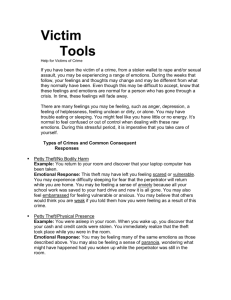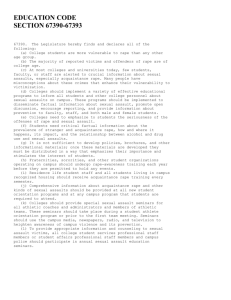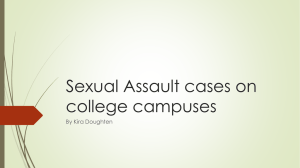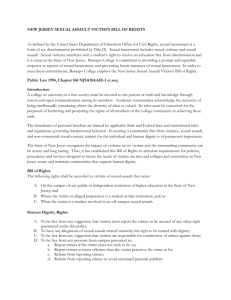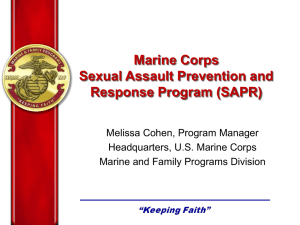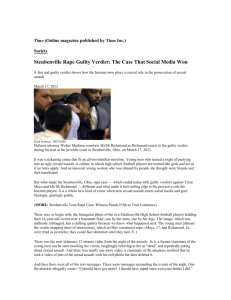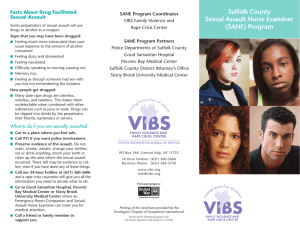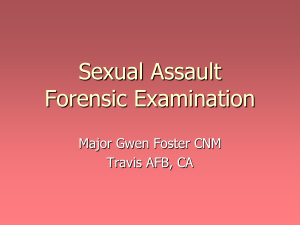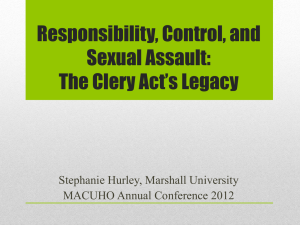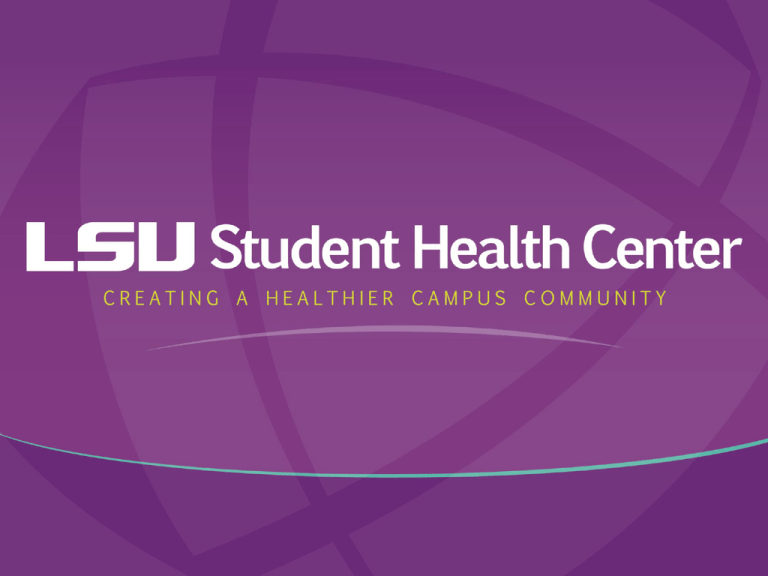
Sexual Assault Victim’s
Advocates (SAVA):
A Toolkit for Establishing Your
Own Campus Program
Seirra Fowler, MPH, CHES
Mendy Escudier, RN, BSN, SANE-A
Louisiana State University
225-578-5718
Outline
• Developing Your Campus Program
Creating a goal and mission statement
Campus and student by-in
Polices, Procedures & Protocols
Community Relationships
Outreach and Advertisement
• Q and A
Why We Need More Programs
Excerpt
SANE
Program
Law
Enforcement
Friends
Housing
University
Accountability
Process
Family
Local Rape Crisis
Center
Significant
Other
Individual
Academics
Religion
Legal
System
Work
Medical
System
Counseling
SAVA
Professors
La R.S. 14:41 Rape; defined
A. Rape is the act of anal, oral or vaginal sexual intercourse with a
male or female person committed without the person’s lawful
consent.
B. Emission is not necessary and any sexual penetration, vaginal or
anal, however slight is sufficient to complete the crime. Being
married to the victim is not a defense to crimes.
C. Oral sexual intercourse means the intentional engaging in any of
the following acts with another person:
1. The touching of the anus or genitals of the victim by the
offender using the mouth or tongue of the offender; or
2. The touching of the anus or genitals of the offender by
the victim using the mouth or tongue of the victim
Establishing the Need
• Institutions of higher education with enrollment of 10,000 students
can anticipate more than 350 rapes or attempted rapes per
academic year
• College age women are 4 x more likely to be assaulted
• <5% of students reported the completed or attempted rape
• According to the FBI, only 2% of rape reports are suspected to be
false – the same rate of false reporting that exists for all other
violent crimes
• 13.1% of female students reported being stalked since the school
year began
• The #1 reason students don’t report the crime: institutional
barriers
The Sexual Victimization of College Women, U.S. Department of Justice, National Institute for Justice, Bureau of Justice Statistics, December 2000;
www.rainn.org
Step 1
Decide what services
you can offer
SAVA Program
• Advocacy
• Referrals
• SANE services
Advocacy
• The period after a traumatic event can be confusing. SAVAs ensure
that no survivor or student-at-risk has to navigate the medical,
legal, mental health, or university system alone.
Some services you may offer:
–
–
–
–
–
–
Assistance with filing a police report
Assistance with obtaining medical care
Assistance with the University Accountability process
Assistance with housing relocation
Academic assistance/accommodations
Referrals to appropriate services and resources
On-Campus Referrals
• Office of the Dean of Students
– Student Advocacy & Accountability
– C.A.R.E. Team
• Disability Services
– Accommodations
• Office of Academic Advising
– Scheduling
• Department of Residential Life
– Housing Accommodations
On-Campus Referrals
• LSU Police Department
• LSU Family Legal Clinic
– Legal advisement/representation
• Mental Health Services
– Crisis intervention and/or continued care
Sexual Assault Nurse Examiner
• The primary mission of any SANE program is to meet the
needs of the sexual assault victim by providing immediate,
compassionate, culturally sensitive, and comprehensive
forensic evaluation and treatment by a specially trained nurse
• SANE is not a patient advocate
Advantages of SANE Programs
• Specialized, specific training
- greater chance of DNA recovery
• More time with the victim
• Higher follow-up rates
• Compassionate, one-on-one care
SANE Forensic Examination
Guidelines
•
•
•
•
•
Person, male or female, must be 15 years or older
A rape kit will be collected up to 4 days post assault
Victim may choose not to report to law enforcement
Victim incurs no charge for evidence collection
Medical screening will be performed even after 4 days
post assault
• Patient has the right to decline SANE and/or SAVA
services
Step 2
Develop your goals and
mission statement
Mission
To provide confidential,
nonjudgmental and appropriate
support services for all sexual
assault survivors, regardless of
gender, ethnicity, sexual
orientation, age, ability, or
whether or not they report the
crime. In addition, the University
has a vested interest in
obtaining an accurate account of
the number of sexual assaults
occurring on- or off-campus
involving student survivors.
Step 3
Get buy-in on your
campus
Clery Act/Dear Colleague Letter
• History of the Jeanne Clery Act
• Requires that colleges/university disclose policy
information and crime statistics as part of a campus
security report published annually
• Dear Colleague Letter
• Department of Education Office of Civil Rights
• Violence Against Women Act
• Campus SaVE (Campus Sexual Violence Elimination Act)
• Effective 2014/15 school year
Faculty and Staff
•
•
•
•
•
•
•
•
Title XI Coordinator
Campus Police
Student Advocacy and Accountability
Residential Life
Student Health Center (Medical, Mental Health, etc.)
Disability Services
Greek Life
SAVA trainings
Continuing Education
• Annual training
– Serves as a refresher for existing advocates and the
opportunity to train new advocates
•
•
•
•
•
Lunch N Learn
Newsletters
Webinars
Outside Trainings
Community Boards/Teams
Step 4
Develop Polices,
Procedures and Protocol
• If possible, try to integrate sexual assault
protocol & procedures into you electronic
health record (EHR)
– This reduces fragmentation of care
– Holds staff accountable with a trackable record of
services offered
Step 5
Develop relationships
with community partners
Community Partners
•
•
•
•
•
•
•
•
•
•
Community Sexual Assault Response Team (SART)
Regional/National Sexual Assault Organizations
Domestic Violence Shelters
Rape Crisis Centers
Hospitals
Mental Health Resources
Police Departments
District Attorney’s Office
Crime Lab
Listservs
Step 6
Get the word out!
•
•
•
•
•
•
•
•
•
•
University Website
Social Media
Campus Newspaper
Brochures
Campus Events
Orientation
Health Fairs
Greek Life Events
Student Organizations
Presentations
Contact Information
Seirra Fowler, MPH, CHES
225-578-6549
seirrafowler@lsu.edu
Mendy Escudier, BSN, RN, SANE-A
225-578-7050
mescud1@lsu.edu
www.shc.lsu.edu

